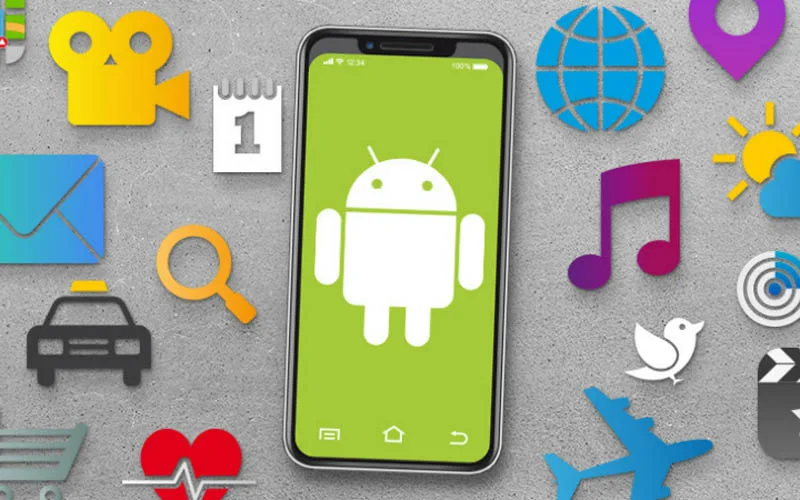Featured
What is Android? History of Development of Android Operating System
Android is a Linux-based open source operating system for mobile devices, home appliances, and business handhelds. In this article, let’s learn more about the operating system, its features, versions and benefits with Getnada.
What is Android

The Android operating system is a Linux-based mobile operating system designed primarily for smartphones and tablets. It includes a comprehensive platform that includes an operating system, graphical user interface (GUI), web browser, and various end-user applications available for download. Initially introduced with smartphones with standard QWERTY keyboards and large VGA screens, Android was designed to work efficiently on affordable handsets equipped with traditional numeric keypads.
Released under the Apache v2 open source license, Android allows developers to create multiple operating system variations for different devices, such as game consoles and digital cameras. Although Android’s platform is open source, most Android devices come pre-installed with proprietary software packages such as Google Maps, YouTube, Google Chrome, and Gmail.
History of Development of Android operating system

Android originated as a startup named Android Inc. in Palo Alto in 2003. The company initially aimed to create an operating system for digital cameras, but soon shifted focus to the broader market of mobile devices.
Google acquired Android Inc. along with its key personnel in 2005 for at least $50 million. Google promoted the nascent mobile platform to handset manufacturers and mobile carriers, highlighting its flexibility and upgradability as primary advantages. While Google was secretly developing Android OS, Apple launched the iPhone in 2007. Earlier Android phone prototypes were similar to BlackBerry devices, featuring physical keyboards and no touchscreens. However, the iPhone’s introduction revolutionized the mobile computing market, compelling Android developers to prioritize touchscreen support. Despite this shift, the first commercially available Android smartphone, the HTC Dream, released in 2008, included a QWERTY keyboard and received mixed reviews.
In late 2007, the formation of the Open Handset Alliance (OHA) was announced, comprising over 30 hardware, software, and telecommunications companies, including Google, Qualcomm, Broadcom, HTC, Intel, Samsung, Motorola, Sprint, Texas Instruments, and Japanese carriers KDDI and NTT DoCoMo. The OHA’s mission was to foster the development of the first open-source platform for mobile devices.
Coinciding with the alliance’s announcement, Google released the public beta version of Android 1.0 for developers in November 2007. Google’s introduction of Android 1.5 in April 2009 marked the beginning of its dessert-themed naming convention, with the version named “Cupcake.” Explaining this naming scheme around the release of Android 4.4 KitKat, Google stated: “Since these devices make our lives so sweet, each Android version is named after a dessert.
What is Technology? Advantages and Impacts of Technology.
Features of Android operating system

Android provides many functions that serve both users and developers. Here are some key features of Android:
Open-source platform
Android is constructed on an open-source Linux kernel, which provides developers with access to the source code, enabling them to modify and enhance it. This open nature promotes innovation and collaboration within the Android ecosystem, allowing a community of developers to contribute to its ongoing development and improvement.
Customizable user interface
Android offers users extensive customization options for their device’s user interface, such as changing wallpapers, themes, widgets, and launchers. This level of personalization allows users to tailor their devices to match their individual preferences and style. This feature distinguishes Android from its primary competitor, iOS, by providing a more flexible and customizable user experience.
Multitasking
Android enables multitasking, allowing users to operate multiple apps at once, switch between them effortlessly, and handle various tasks concurrently. Additionally, users can utilize the split-screen mode to display and interact with two apps side by side, enhancing productivity and convenience.
Google Play Store
Android users have access to the Google Play Store, which features an extensive collection of apps, games, movies, music, books, and more. This centralized platform allows users to easily discover, download, and install a wide variety of content for their devices.
Google Assistant
Android devices are equipped with Google Assistant, an AI-powered virtual assistant. Google Assistant can handle numerous tasks, answer queries, offer recommendations, and manage smart home devices, all through voice commands.
Security features
Android includes a range of security features designed to safeguard users’ data and privacy. These include app sandboxing to isolate applications, secure boot processes, encrypted file systems, Google Play Protect for app security, and ongoing security updates provided by device manufacturers.
Accessibility
Android offers a comprehensive array of accessibility features to support users with disabilities or special needs. These features include screen readers, magnification gestures, color inversion, text-to-speech functionality, and more, ensuring a more inclusive user experience.
Google Services integration
Android devices integrate effortlessly with Google services like Gmail, Google Maps, Google Drive, Google Photos, and more. This seamless integration grants users access to a comprehensive suite of productivity tools, communication services, and cloud storage options, enhancing their overall experience and efficiency.
Android OS versions

Google frequently updates the Android OS, introducing incremental improvements, security patches, and performance enhancements with each release.
Android 1.0: Launched on September 23, 2008, this version included a suite of Google apps like Gmail, Maps, Calendar, and YouTube.
Android 1.5 (Cupcake): Released on April 27, 2009, it introduced an on-screen virtual keyboard and the framework for third-party app widgets.
Android 1.6 (Donut): Released on September 15, 2009, it added support for various screen sizes and resolutions and CDMA networks.
Android 2.0 (Eclair): Released on October 26, 2009, it featured turn-by-turn voice navigation, real-time traffic information, and pinch-to-zoom functionality.
Android 2.2 (Froyo): Released on May 20, 2010, this version introduced a dock at the bottom of the home screen, voice actions, and support for Flash in the web browser.
Android 2.3 (Gingerbread): Released on December 6, 2010, it introduced a black and green UI theme.
Android 3.0 to 3.2 (Honeycomb): Launched on February 22, 2011, this tablet-exclusive version featured a blue, space-themed holographic design.
Android 4.0 (Ice Cream Sandwich): Released on October 18, 2011, it unified the UI for tablets and smartphones and emphasized swiping for navigation.
Android 4.1 to 4.3 (Jelly Bean): Released on July 9, 2012, November 13, 2012, and July 24, 2013, respectively, these versions introduced Google Now, interactive notifications, and an improved voice search system.
Android 4.4 (KitKat): Released on October 31, 2013, it brought lighter UI colors, a transparent status bar, and white icons.
Android 5.0 (Lollipop): Launched on November 12, 2014, it featured a card-based design and hands-free voice control with the “OK, Google” command.
Android 6.0 (Marshmallow): Released on October 5, 2015, it introduced more granular app permissions, USB-C support, and fingerprint reader integration.
Android 7.0 and 7.1 (Nougat): Released on August 22, 2016, and October 4, 2016, respectively, these versions introduced a native split-screen mode and bundled notifications.
Android 8.0 and 8.1 (Oreo): Released on August 21, 2017, and December 5, 2017, respectively, they introduced picture-in-picture mode, notification snoozing, and Project Treble for standardized updates.
Android 9.0 (Pie): Launched on August 6, 2018, it replaced traditional navigation buttons with a multifunctional Home button, added productivity features like suggested replies, and improved brightness management.
Android 10 (Android Q): Released on September 3, 2019, it switched to swipe-based navigation, introduced a dark theme, and added Focus Mode to minimize distractions.
Android 11 (Red Velvet Cake): Released on September 8, 2020, it added built-in screen recording, centralized conversation management across messaging apps, and updated chat bubbles.
Android 12 (Snow Cone): Launched on October 4, 2021, it offered extensive UI customization options, a conversation widget for preferred contacts, and enhanced privacy features.
Android 12L: Released on March 7, 2022, it optimized the UI for larger screens, such as tablets and foldables, with features like a dual-panel notification center.
Android 13 (Tiramisu): Launched on August 15, 2022, it included more customization options, improved security controls, and enhanced multitasking capabilities across multiple devices.
Android 14 (Upside Down Cake): Released on October 4, 2023, it introduced more lock screen and wallpaper customization, improved OS efficiency to reduce battery strain, larger scalable fonts for vision-impaired users, and visual notifications for hearing-impaired users. Enhanced security updates included better data-sharing transparency, improved PIN security, and expanded passkey authentication support.
Hardware platform does Android use

Android initially uses ARM architecture for its hardware platform, but later versions have extended support to x86 and x86-64 architectures. Starting in 2012, Android smartphones and tablets featuring Intel processors were introduced by device manufacturers.
The minimum hardware requirements for Android vary based on the device’s screen size and CPU type and density. Initially, Google specified a 200 MHz processor, 32 MB of storage, and 32 MB of RAM as the minimum requirements.
Google provides documentation outlining the hardware requirements that original equipment manufacturers (OEMs) must meet for a device to be “Google Approved,” which ensures it ships with official Google apps. However, due to Android’s open-source nature, it can also operate on lower-spec hardware, offering flexibility in device configurations.
What is Android?
Android is an open-source operating system developed by Google, designed primarily for touchscreen mobile devices such as smartphones and tablets. It is based on the Linux kernel and provides a rich application framework that allows developers to build innovative apps and games for mobile devices.
What are the main features of Android OS?
Key features of Android OS include a customizable user interface, support for multitasking, a wide range of hardware compatibility, access to the Google Play Store for apps and games, integration with Google services, and regular system updates for security and new features.
How do I update my Android device?
To update your Android device, go to Settings > System > Advanced > System update. If an update is available, follow the on-screen instructions to download and install it. The exact steps may vary depending on the device manufacturer and Android version.



